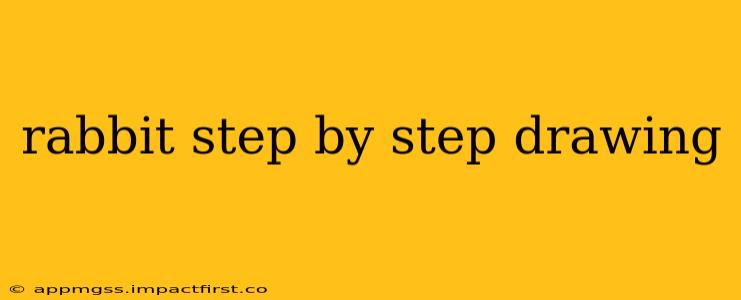Learning to draw a rabbit can be a fun and rewarding experience, whether you're a complete beginner picking up a pencil for the first time or an experienced artist looking for a new challenge. This step-by-step guide will walk you through the process, offering tips and tricks to help you create a charming and realistic rabbit drawing. We'll cover different approaches, from simple cartoon rabbits to more detailed, realistic renderings.
Step 1: Basic Shapes – The Foundation of Your Rabbit
Before diving into intricate details, we start with basic shapes. Think of your rabbit as a collection of simple forms: circles, ovals, and triangles. This helps establish the overall proportions and posture.
- Head: Begin with a large oval for the head. Its size will determine the overall size of your rabbit.
- Body: Add a slightly smaller oval connected to the head, representing the body. The connection point should be smooth and natural, not a sharp angle.
- Ears: Two long, slightly curved triangles emerge from the top of the head, forming the ears. These can be pointed or rounded, depending on the rabbit breed you're aiming for.
- Legs: Use small ovals or cylinders for the legs. Remember to consider the rabbit's pose – are they sitting, hopping, or standing? This will influence the placement and angle of the legs.
Step 2: Refining the Shapes – Adding Curves and Defining Features
Now, let's refine those basic shapes. Instead of hard lines, use smooth, curved lines to connect and soften the edges. This brings a more organic and natural feel to your drawing.
- Head: Smooth out the oval, adding a slightly more pointed chin and a gentle curve at the top of the head.
- Body: Soften the connection between the head and body. Add a subtle curve to the body to suggest a rounded shape.
- Ears: Refine the ear shapes, adding a slight curve to the inner edges and a point at the tip.
- Legs: Add more detail to the legs, suggesting volume and shape. Use slight curves to avoid stiff, straight lines.
Step 3: Adding Details – Eyes, Nose, and Mouth
Now for the fun part – adding the facial features! These details bring your rabbit to life.
- Eyes: Draw two small, dark circles for the eyes. Their placement should be symmetrical and relatively close together.
- Nose: A small, triangular or teardrop shape works well for the nose.
- Mouth: A simple curved line or two small dots can represent the mouth.
Step 4: Fur and Texture – Bringing Depth to Your Rabbit
To make your rabbit drawing truly stand out, adding fur and texture is essential. This adds depth and realism.
- Fur: Use short, light strokes to suggest fur. The strokes should follow the direction of the rabbit's body.
- Shading: Add shading to create depth and dimension. Pay attention to light sources and how they affect the rabbit's form. Darker areas are usually found under the chin, behind the ears, and underneath the body.
How to Draw Different Types of Rabbits?
Cartoon Rabbit: Simplify the shapes even further. Use larger, rounder forms for the head and body. Exaggerate the features – big eyes, a small nose, and long ears.
Realistic Rabbit: Focus on detailed anatomy and fur. Study photographs of rabbits to understand their musculature and how their fur lies. Use a variety of shading techniques to create a three-dimensional effect.
Different Rabbit Breeds: Research different rabbit breeds (e.g., Flemish Giant, Dutch, Lop) to understand their unique characteristics. Consider ear shapes, body proportions, and fur type when drawing different breeds.
What supplies do I need to draw a rabbit?
You'll only need a few basic supplies to start drawing your rabbit:
- Pencil: A standard HB or 2B pencil is a great starting point.
- Eraser: To correct mistakes.
- Paper: Any drawing paper will do.
- Optional: Colored pencils, markers, or paints for adding color to your finished drawing.
What are some tips for drawing a realistic rabbit?
- Observe real rabbits: Studying photographs or observing real rabbits is crucial for understanding their anatomy and behavior.
- Use references: Don't be afraid to use reference images.
- Practice: The key to improvement is practice. The more you draw, the better you'll get.
- Be patient: Drawing takes time and patience. Don't get discouraged if your first attempt isn't perfect.
This guide provides a solid foundation for drawing rabbits. Remember to experiment, have fun, and let your creativity flow! With practice and patience, you'll be creating stunning rabbit drawings in no time.
